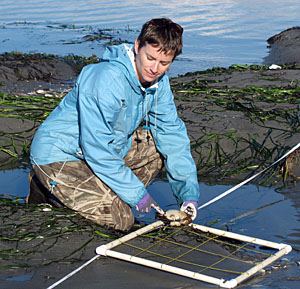In the 1920s, San Francisco oystermen harvested Olympia oysters from Elkhorn Slough by the bushel. Overharvesting, however, soon decimated the population of these tasty little oysters, the only native oyster on the Pacific coast. They are now rare in Elkhorn Slough and in danger of going locally extinct.
Kerstin Wasson aims to keep that from happening. Wasson is an adjunct professor of ecology and evolutionary biology at UC Santa Cruz and research coordinator for the Elkhorn Slough National Estuarine Research Reserve. This dual role allows her to bring rigorous science to bear on habitat restoration efforts throughout Elkhorn Slough. Restoring the native oysters is just one aspect of a broad-based effort to do science-based ecosystem management at Elkhorn Slough.
Working with UCSC graduate students and researchers, as well as with reserve staff, volunteers, and the Elkhorn Slough Foundation, Wasson monitors the ecosystem of the slough, studies the habitat needs of native species, designs restoration projects, and evaluates the effectiveness of restoration efforts.
"All the research I do is directly related to understanding threats to the ecosystem or developing solutions," Wasson said. "I have found that a lot of UCSC students love the idea of doing work that can translate directly into improved conservation strategies."
Elkhorn Slough is one of the largest estuaries in California, with the largest tract of tidal salt marsh in the state outside of San Francisco Bay. Although it has been dramatically changed by human activities over the past century--from intensive farming in the surrounding watershed to water control structures in the slough--it still provides critical habitat for hundreds of species of plants and animals. It serves as a nursery for many kinds of fish and is an important stop-over for migrating birds.
"It is still a very rich ecosystem, so we want to be sure that any restoration projects we undertake are going to make it better," Wasson said.
In the case of Olympia oysters, Wasson began by studying the factors that currently limit the growth of the population. She published her findings in a recent paper in the journal Wetlands.
One problem is that the oysters tend to get buried by fine sediments washed into the slough from erosion of farmlands. The oysters need a hard substrate to grow on, so Wasson's team is using clam shells to build reefs where the oysters can grow without getting buried in mud. The clam shells are collected from the mouth of the estuary, where they are abundant due to the feeding habits of local sea otters. The researchers are trying out different techniques and locations for deploying the clam-shell reefs, and data from pilot studies will be used to guide more extensive restoration projects in the future.
"Habitat restoration is often done as an art form, but we want to do it as a science so that we can adjust our approach based on what the data tell us," Wasson said.
The oysters are also threatened by poor water quality and by non-native sponges and other invasive species that overgrow them in deeper water. In the long term, the oysters will benefit from a broad ecosystem management program that aims to restore more natural tidal flows and reduce the amounts of nutrients and sediments entering the slough from surrounding farmland.
"Ultimately, we'd like to stop the burial of oysters by sediments and improve overall water quality through restoration measures that would benefit the whole system. But the danger is that they could go extinct in this estuary if we don't act in the short term," Wasson said.
One approach to improving the Elkhorn Slough ecosystem focuses on the surrounding watershed. The Elkhorn Slough Foundation, in partnership with the reserve and other organizations, has been acquiring and restoring land around the slough. Land previously used to grow strawberries and other intensive crops has been converted to open space with native species or planted with crops such as rosemary that require less tillage and fertilization.
A recent study led by Alison Gee, a research associate at UCSC's Institute of Marine Sciences, showed that these restoration projects have measurably improved water quality in Elkhorn Slough. The researchers found the greatest improvements where the restoration was done immediately adjacent to the wetland and covered a relatively large area of land.
"Closer and bigger is definitely better when it comes to watershed restoration," said Wasson, a coauthor of the study, which was published in the journal Estuaries and Coasts. "But we were still able to measure an effect when the restored land was farther away and covered a smaller proportion of the watershed."
Perhaps the most complex issue in Elkhorn Slough involves the changes people have made to the movement of water--both tidal exchange and the flow of fresh water into the slough. The opening of the harbor mouth at Moss Landing in 1947 dramatically increased the volume of water flowing in and out of the slough with the tides, resulting in tidal erosion and loss of marshland. Diking and draining of wetlands caused additional losses. About 50 percent of Elkhorn Slough's tidal marshes have been lost within the past 70 years.
At the same time, diversion of the Salinas River and pumping of groundwater for irrigation have reduced the amount of fresh water entering the slough. As a result, plants that require more fresh water, such as cattails and rushes, have become less common.
While historical records show the changes that have taken place over the past century, deeper records of the natural range of variation in the estuary can be found in sediment cores that preserve fossil pollen and other evidence of past conditions. A study of sediment cores led by UCSC postdoctoral researcher Beth Watson found that Elkhorn Slough is still within its natural range in terms of salt marsh acreage, which has varied considerably over time. By other measures, however--notably the composition of the salt marsh community--the slough is now far outside of its natural range.
"The salt marshes now are pretty much a monoculture of pickleweed, whereas there used to be much more representation of species that require freshwater inputs," Wasson said.
There are many complex trade-offs to be evaluated in managing an ecosystem that has been so highly altered by human activities. In 2004, Wasson helped launch an ecosystem-based management initiative that brought together over 100 stakeholders and scientists to develop a vision and strategies for better management of the estuary. The Elkhorn Slough Tidal Wetland Project published a strategic plan in 2007 to help guide restoration projects.
The current Parsons Slough project, for example, involves building a sill designed to limit the tidal erosion and flooding that degrade tidal marshes, while allowing sufficient tidal exchange and flushing to maintain good water quality. It is supported by about $4.5 million in federal stimulus funds.
"The research we do directly informs these ongoing efforts to improve ecosystem functions in the estuary," Wasson said. "My position allows me to serve as a bridge between the conservation practitioners and managers at Elkhorn Slough and the scientific expertise at UCSC."
For more information, visit the Elkhorn Slough web site or Wasson's UCSC research site.



